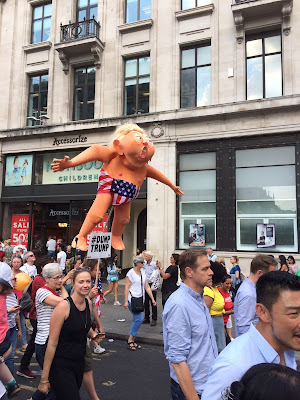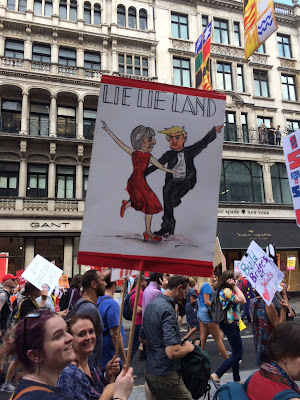June 1999 was arguably the high point of the Association of Autonomous Astronauts in its UK zone of operations. It was then that the AAA organised 'Space 1999: ten days that shook the Universe - a festival of independent and community-based space exploration', held in London from June 18 to June 27 of that year.
 |
| Space 1999 Programme: Front (the programme was designed by AAA Glasgow Cabal/Datamedia Design) |
The festival featured an ambitious range of events including among other things a conference, games of three sided football, an Extraterrestrial Cinema night, a 'military out of space' protest as part of the Reclaim the Streets J18 Carnival against Capital, and gigs including one with Nocturnal Emissions and a space pop night at famous LGBTQ+ venue the Vauxhall Tavern. This diversity reflected the exotic cocktail of ingredients informing the AAA project, including radical art/anti-art, left communism/situationists, post Temple ov Psychick Youth occulture, techno, science fiction and of course a desire to get into space.
 |
| Space 1999 Programme |
The ten days also included the summer solstice for that year on June 21st, providing an opportunity for an AAA training event. The programme promised 'Solstice outdoor training for autonomous astronauts, featuring star navigation, low level gravity practice, dreamtime workshop and astral projection exercise'. I wrote the following report of it in my guise as Neil Disconaut in the festival's daily newsletter:
'20+ intrepid travelers gathered at Hampstead Heath station for a magickal mystery tour that was to take them to Parliament Hill, outer space and back within three hours. The solstice training event, facilitated by Neil and Juleigh Disconaut, kicked off with some theoretical orientation using nursery rhymes to demonstrate that most of us have been in training to be astronauts since we floated semi-weightless in the womb. The full meaning of lines like “I saw an old woman flying high in a basket, 17 times as high as the moon"will only become apparent when we go into space.
Next stop was the children’s playground, locked for the night but swiftly reclaimed by the innovative use of dustbins to scale the fence. Exercises included gravity awareness on the swings and disorientation on the roundabouts. The possible use of the seesaw to catapult people into space was also explored.
Imagination training was carried out under an Oak tree on the hill, dressed with candles, stars and other decorations. Nobody volunteered to climb to the top to see if this was actually the World Tree with its roots in the underworld and its branches touching the sky. A discussion of reclaiming our sense of our relationship to the stars, and of the significance of the solstice, was interrupted by some kids asking us for drugs. Asked for their suggestions of how to get into space, one of them came up with the idea of a tunnel leading from Earth to the moon.
Dreaming is the cheapest and easiest way to fly, and there was discussion of various techniques for inducing dreams about space, such as sigilization. Neil described his dream experiments from which he concluded that in our dreams as in the rest of our lives the social gravity of capitalism inhibits the flight of the imagination. While he had succeeded in having some dreams of flying, this had had to struggle against numerous dreams featuring work, school, the police and other horrors.
After some astral body aerobic exercises contributed by Phil [Hine], John Eden facilitated an astral projection exercise inviting people to float above the heath and out to the stars. There were some interesting experiences with one person reporting that the space she had visited was quite noisy with lots of birds sounds.
The night wound up with some eating and drinking and with people from the band “They came from the stars” playing on toy musical instruments'.
 |
| our outline notes for the event |
 |
| The post festival report, which reprinted the above article and states 'a CIP catalogue record of this book is available on Hampstead Heath'. |















































